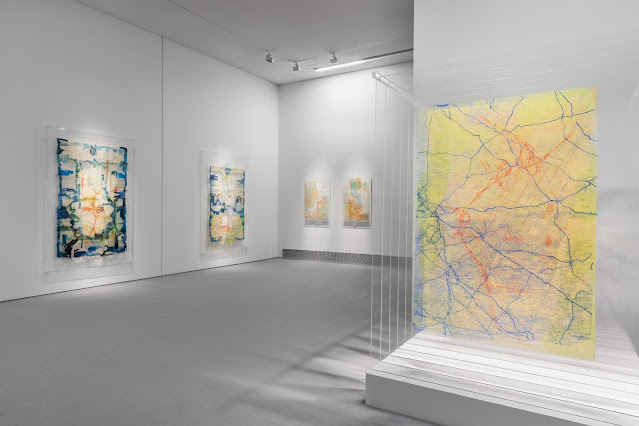ΑΜΟΥΡ η Χρύσα στις πόλεις (Greece 2023)
One channel video projection with ambient sound
English subtitles
essay - experimental
Duration: 17 min
Video installation homage to the artist CHRYSSA ROMANOS from the exhibition THE SEARCH FOR HAPPINESS FOR AS MANY AS POSSIBLE, produced in collaboration with EMST.
The video serves as an epilogue to the exhibition of Chrysa Romanou. Its starting point is the book of the same name, Amour, which was an interpretation of the photographic archive of Nikos Kessanlis, Romanos' life partner. The video is enriched with additional audiovisual material, with the creative collaboration of artists Dimitris Tsoublekas and Georges Salameh and writer Amanda Michalopoulou. In a chained audiovisual narrative, Chrysa, like a long-distance runner, sets up exhibitions, smokes, discusses and runs through cities and country landscapes - in essence, her own life.
Chryssa Romanos Luna Park International, 1965, collage on canvas, 200 x 200 cm
Βιντεοεγκατάσταση-αφιέρωμα στην καλλιτέχνιδα ΧΡΥΣΑ ΡΩΜΑΝΟΥ από την έκθεση
Η ΑΝΑΖΗΤΗΣΗ ΤΗΣ ΕΥΤΥΧΙΑΣ ΓΙΑ ΟΣΟΥΣ ΠΕΡΙΣΣΟΤΕΡΟΥΣ ΓΙΝΕΤΑΙ, σε συνεργασία με το ΕΜΣΤ.
Το βίντεο λειτουργεί σαν επίλογος της έκθεσης της Χρύσας Ρωμανού. Αφετηρία του είναι το ομότιτλο βιβλίο Amour, που ήταν μια ερμηνεία του φωτογραφικού αρχείου του Νίκου Κεσσανλή, συντρόφου ζωής της Ρωμανού. Το βίντεο είναι εμπλουτισμένο με επιπλέον οπτικοακουστικό υλικό, με τη δημιουργική συνεργασία των καλλιτεχνών Δημήτρη Τσουμπλέκα και Γιώργου Σαλαμέ και της συγγραφέα Αμάντας Μιχαλοπούλου. Σε μια αλυσιδωτή οπτικοακουστική αφήγηση, η Χρύσα, σαν δρομέας μεγάλων αποστάσεων, στήνει εκθέσεις, καπνίζει, συζητάει και διατρέχει πόλεις και εξοχικά τοπία – στην ουσία την ίδια της τη ζωή.

Installation view of the exhibition: Chryssa Romanos. The Search for Happiness for as Many as Possible Photo: Paris Tavitian
Open-ended narrative structures, mechanical reproduction, randomness, transparency, and the notion of play characterise her body of work. From her very first works, the motif of the labyrinth, the critique of consumerism, the political interest in social inequalities and injustice, the democratisation of art, the osmosis of art and everyday life, and the interest in travel recur as main thematic axes, and evolve as the artist herself matures and her social and political environment transforms.
The exhibition The Search for Happiness for as Many as Possible includes works from almost all periods of her oeuvre, highlighting their correlation and relationship. At the same time, it situated the works in their historical, political, and social context. The exhibition parcours begins with Myths, the paintings originating from the period when she left for Paris. It continues with the historical collages of 1965; the grand Meccano sculptural constructions, inspired kit toys of the same name typically intended for boys; silkscreen prints from the famed Mec Art Graphic atelier in Paris; and culminates into her most mature works, the Maps-Labyrinths, with their notable décollage technique on Plexiglas. Finally, it concludes with a video work based on the rich photographic archive of Chryssa Romanos and her husband, the equally influential artist and Athens School of Fine Arts professor Nikos Kessanlis, emphasising the indissoluble and reciprocal relationship between art and life.
The exhibition title is derived from a text by the eminent French theorist Pierre Restany found in a catalogue devoted to Chryssa Romanos and brings to the surface both the emotional and political dimensions of her work.

Installation view of the exhibition: Chryssa Romanos. The Search for Happiness for as Many as Possible Photo: Paris Tavitian
Η Χρύσα Ρωμανού (1931-2006) είναι μια από τις σημαντικότερες Ελληνίδες καλλιτέχνιδες που αναδύθηκαν την δεκαετία του 1960. Ανήκει στην ομάδα των Ελλήνων διανοουμένων της διασποράς που έζησαν και εργάστηκαν σε καλλιτεχνικά κέντρα της Δύσης και για πρώτη φορά στην ιστορία της ελληνικής τέχνης συμμετείχαν ενεργά στη διαμόρφωση διεθνών ρευμάτων της εποχής τους. Τα είκοσι χρόνια που η Ρωμανού έζησε στο Παρίσι (1961-1981) ήταν καθοριστικά για την διάπλαση της καλλιτεχνικής της ταυτότητας.
Το έργο της χαρακτηρίζεται από τις ανοιχτές αφηγηματικές δομές, τη μηχανική αναπαραγωγή, το τυχαίο, τη διαφάνεια, το παιχνίδι. Από τα πρώτα της βήματα, το μοτίβο του λαβύρινθου, τα ταξίδια, η κριτική στην κοινωνία της κατανάλωσης, το πολιτικό ενδιαφέρον για τις κοινωνικές ανισότητες και την αδικία, ο εκδημοκρατισμός της τέχνης, η ώσμωση τέχνης και καθημερινότητας επανέρχονται ως κεντρικοί θεματικοί άξονες και εξελίσσονται όσο η καλλιτέχνης ωριμάζει και μεταβάλλεται το κοινωνικό και πολιτικό περιβάλλον.
Η έκθεση Η αναζήτηση της ευτυχίας για όσους περισσότερους γίνεται περιλαμβάνει έργα από όλες σχεδόν τις ενότητες της δουλειάς της, προκειμένου να αναδείξει τη συνάφεια και την οργανική σχέση μεταξύ τους. Παράλληλα, εντάσσει τα έργα στο ιστορικό, πολιτικό και κοινωνικό τους πλαίσιο. Η περιήγηση ξεκινά με τους Μύθους, τα ζωγραφικά έργα της περιόδου που έφυγε για το Παρίσι. Συνεχίζει με τα ιστορικά κολάζ του 1965, τις μεγάλες γλυπτικές κατασκευές Meccano –εμπνευσμένες από το ομώνυμο παιχνίδι κατασκευών το οποίο απευθυνόταν στερεοτυπικά στα αγόρια–, τις μεταξοτυπίες από το περίφημο ατελιέ της Mec Art Graphic στο Παρίσι, και καταλήγει στα ωριμότερα έργα της, τους Χάρτες-Λαβυρίνθους με την χαρακτηριστική τεχνική του ντεκολάζ σε πλέξιγκλας. Τέλος, η έκθεση, ολοκληρώνεται με ένα βίντεο βασισμένο στο πλούσιο φωτογραφικό αρχείο της Χρύσας Ρωμανού και του συζύγου της, του εξίσου σπουδαίου καλλιτέχνη και καθηγητή της ΑΣΚΤ, Νίκου Κεσσανλή, τονίζοντας την άρρηκτη και αμφίδρομη σχέση τέχνης και ζωής.
Ο τίτλος της έκθεσης προέρχεται από κείμενο του σημαντικού Γάλλου θεωρητικού Pierre Restany σε κατάλογο της Χρύσας και αναδεικνύει τόσο την συναισθηματική όσο και την πολιτική διάσταση του έργου της.




